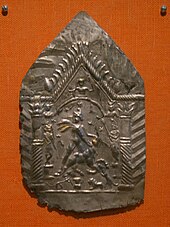Votive sheet

Mercury votive sheet from the Weißenburg treasure trove .
|
The votive sheet (from Latin vovere = vow, votum = vow) is in the Greco-Roman antiquity a votive offering made of chased sheet metal for one or more gods. The preserved votive sheets are made of gold , silver or bronze and are up to 30 cm high. Good examples are found in the Roman museum White Castle from the Weißenburger treasure , there were found 11 votive. A similar closed find from Mauer near Amstetten is available from Austria . The use of the sheet metal is unclear and controversial: either they were nailed directly to walls or they were attached to painted wooden boards and hung on temple walls as decoration and thus belonged to their inventory or they served as fittings for consecrated boxes and shrines or as protection and cover for consecrated statuettes of gods that were placed on or in the earth.
literature
- Hans-Jörg Kellner , Gisela Zahlhaas: The Roman treasure find from Weissenburg. 3rd extended edition, Schnell and Steiner, Regensburg 1997 ISBN 3-7954-1104-1 ( Exhibition Guide Prehistoric State Collection Munich 2).
- Rudolf Noll: The inventory of the Dolichenus sanctuary from Mauer an der Url (Noricum). Verlag der Österr. Akad. D. Wiss., Vienna 1980 ( The Roman Limes in Austria 30).
- Gisela number Haas: The Roman treasure trove of White Castle. in: Antike Welt 3/1985, p. 38ff.
